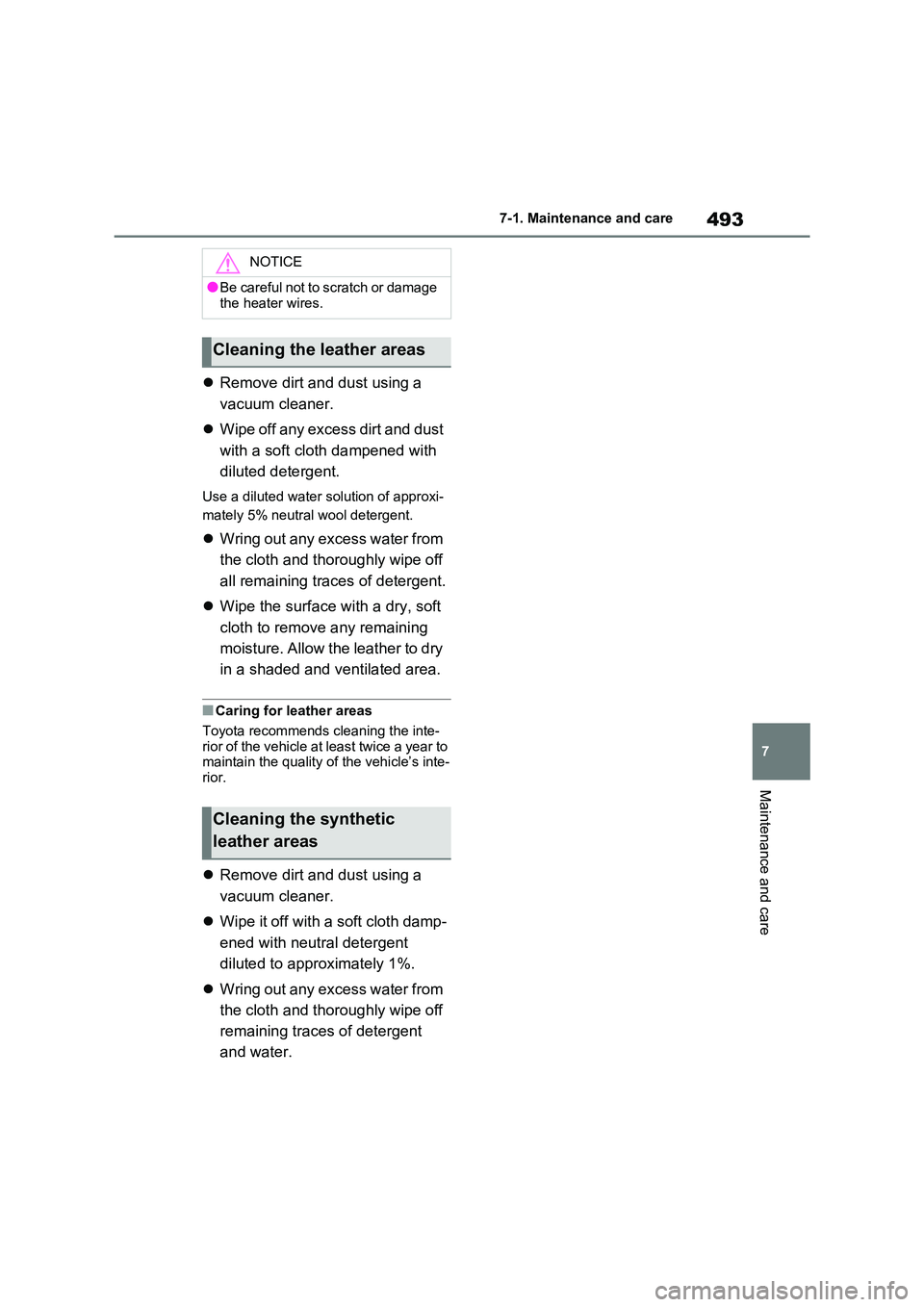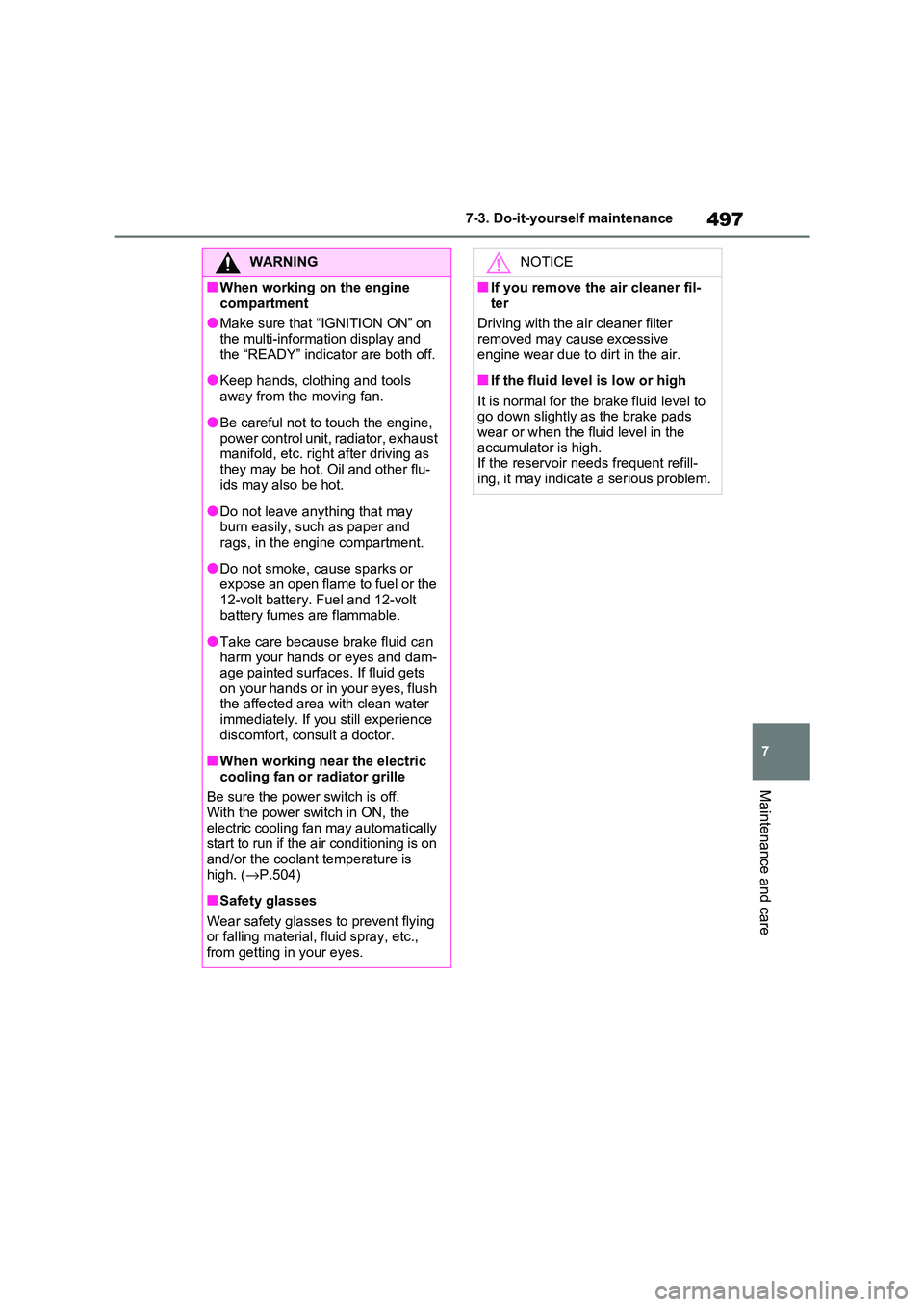Page 495 of 666

493
7
7-1. Maintenance and care
Maintenance and care
Remove dirt and dust using a
vacuum cleaner.
W i p e o f f a n y e x c e s s d i r t a n d d u s t
with a soft cloth dampened with
diluted detergent.
Use a diluted water solution of approxi -
mately 5% neutral wool detergent.
Wring out any excess water from
the cloth and thoroughly wipe off
all remaining traces of detergent.
Wipe the surface with a dry, soft
cloth to remove any remaining
moisture. Allow the leather to dry
in a shaded and ventilated area.
■Caring for leather areas
Toyota recommends cleaning the inte -
rior of the vehicle at least twice a year to maintain the quality of the vehicle’s inte-
rior.
Remove dirt and dust using a
vacuum cleaner.
Wipe it off with a soft cloth damp-
ened with neutral detergent
diluted to approximately 1%.
Wring out any excess water from
the cloth and thoroughly wipe off
remaining traces of detergent
and water.
NOTICE
●Be careful not to scratch or damage
the heater wires.
Cleaning the leather areas
Cleaning the synthetic
leather areas
Page 496 of 666

4947-2. Maintenance
7-2.Maintenance
■Where to go for maintenance ser-
vice?
In order to maintain y our vehicle in the best possible condition, Toyota recom -
mends that maintenance service opera -
tions as well as other inspections and repairs be carried out by authorized
Toyota retailers or Toyota authorized
repairers, or any relia ble repairers. For repairs and services covered by your
warranty, please vi sit an authorized
Toyota retailer or repairer, who will use genuine Toyota parts in repairing any
difficulties you may encounter. There
can also be advantages in utilizing authorized Toyota reta ilers or repairers
for non-warranty repairs and services,
as members of the Toyota network will be able to expertly assist you with any
difficulties you may encounter.
Your Toyota retailer or Toyota autho -
rized repairer, or any reliable repairer will perform all of the scheduled mainte -
nance on your vehicle reliably and eco -
nomically due to the ir experience with Toyota vehicles.
Scheduled maintenance should be
performed at speci fied intervals
according to the maintenance
schedule.
For full details of your maintenance
schedule, refer to the “Toyota Service
Booklet” or “Toyota Warranty Booklet”.
What about do-it-yourself mainte -
nance?
Many maintenance it ems are easy to
do yourself if you have a little mechani -
cal ability and a few basic automotive
tools.
Note, however, that some maintenance
tasks require specia l tools and skills.
These are best per formed by qualified
technicians. Even if you’re an experi -
enced do-it-yourself mechanic, we rec -
ommend that repairs and maintenance
be conducted by any authorized Toyota
retailer or Toyota authorized repairer,
or any reliable repairer. Any authorized
Toyota retailer or repairer will keep a
record of maintenance, which could be
useful should you ever require War -
ranty Service. Should you choose to
select a qualified and equipped profes -
sional other than an authorized Toyota
repairer to service or maintain your
vehicle, we recommend that you
Maintenance require-
ments
To ensure safe and economical
driving, day-to-day care and
regular maintenance are
essential. Toyota recom -
mends the maintenance below.
WARNING
■If your vehicle is not properly
maintained
Improper maintenanc e could result in
serious damage to the vehicle and
possible death or serious injury.
■Handling of the 12-volt battery
12-volt battery posts, terminals and
related accessories contain lead and
lead compounds which are known to cause brain damage. Wash your
hands after handling. ( →P.506)
Scheduled maintenance
Do-it-yourself maintenance
Page 497 of 666

495
7
7-2. Maintenance
Maintenance and care
request that a record of maintenance
be kept.
■Does your vehicle need repairs?
Be on the alert for changes in perfor - mance and sounds, a nd visual tip-offs
that indicate service is needed. Some
important clues are:
●Engine missing, stumbling or pinging
●Appreciable loss of power
●Strange engine noises
●A fluid leak under the vehicle (How-
ever, water dripping from the air con - ditioning system after use is normal.)
●Change in exhaust sound (This may indicate a dangerous carbon monox -
ide leak. Drive with the windows open
and have the exhau st system checked immediately.)
●Flat-looking tires, excessive tire squeal when cornering, uneven tire
wear
●Vehicle pulls to one side when driven
straight on a level road
●Strange noises related to suspension
movement
●Loss of brake effectiveness, spongy
feeling brake pedal, pedal almost
touches the floor, vehicle pulls to one
side when braking
●Engine coolant temperature continu -
ally higher than normal ( →P.174)
If you notice any of these clues, take
your vehicle to any authorized Toyota
retailer or Toyota authorized repairer, or any reliable repair er as soon as possi-
ble.
Your vehicle may need adjustment or repair.
Page 498 of 666

4967-3. Do-it-yourself maintenance
7-3.Do-it-yourself maintenance
Do-it-yourself service
precautions
If you perform maintenance by
yourself, be sure to follow the
correct procedure as given in
these sections.
Maintenance
ItemsParts and tools
12-volt battery
condition
( →P.506)
•Grease
• Conventional
wrench (for terminal
clamp bolts)
Engine/power
control unit
coolant level
( →P.503)
• “Toyota Super Long
Life Coolant” or a
similar high quality
ethylene glycol-
based non-silicate,
non-amine, non-
nitrite and non-
borate coolant with
long-life hybrid
organic acid technol -
ogy
“Toyota Super Long
Life Coolant” is pre -
mixed with 50%
coolant and 50%
deionized water.
• Funnel (used only
for adding coolant)
Engine oil level
( →P.501)
• “Toyota Genuine
Motor Oil” or equiva -
lent
• Rag or paper towel
• Funnel (used only
for adding engine
oil)
Fuses
( →P.545)
• Fuse with same
amperage rating as
original
DC/DC Con -
verter air
intake vent
( →P.536)
• Vacuum cleaner,
etc,
• Phillips screwdriver
Light bulbs
( →P.548)
• Bulb with same
number and watt -
age rating as origi -
nal
• Phillips-head screw -
driver
• Flathead screw -
driver
• Wrench
Radiator and
condenser
( →P.504)
⎯
Tire inflation
pressure
( →P.529)
• Tire pressure gauge
• Compressed air
source
Washer fluid
( →P.505)
• Water or washer
fluid containing anti -
freeze (for winter
use)
• Funnel (used only
for adding water or
washer fluid)
WARNING
The engine compartment contains
many mechanisms and fluids that may move suddenly, become hot, or
become electrically energized. To
avoid death or serious injury, observe the following precautions.
ItemsParts and tools
Page 499 of 666

497
7
7-3. Do-it-yours elf maintenance
Maintenance and care
WARNING
■When working on the engine
compartment
●Make sure that “IGNITION ON” on the multi-information display and
the “READY” indicat or are both off.
●Keep hands, clothing and tools
away from the moving fan.
●Be careful not to touch the engine, power control unit, radiator, exhaust
manifold, etc. right after driving as
they may be hot. Oil and other flu - ids may also be hot.
●Do not leave anyt hing that may burn easily, such as paper and
rags, in the engi ne compartment.
●Do not smoke, cause sparks or
expose an open flame to fuel or the
12-volt battery. Fu el and 12-volt battery fumes are flammable.
●Take care because brake fluid can harm your hands or eyes and dam -
age painted surfac es. If fluid gets
on your hands or in your eyes, flush the affected area with clean water
immediately. If you still experience
discomfort, consult a doctor.
■When working near the electric
cooling fan or radiator grille
Be sure the power switch is off.
With the power swi tch in ON, the
electric cooling fan may automatically start to run if the air conditioning is on
and/or the coolant temperature is
high. ( →P.504)
■Safety glasses
Wear safety glasses to prevent flying or falling material, fluid spray, etc.,
from getting in your eyes.
NOTICE
■If you remove th e air cleaner fil-
ter
Driving with the air cleaner filter removed may cause excessive
engine wear due to dirt in the air.
■If the fluid level is low or high
It is normal for the br ake fluid level to
go down slightly as the brake pads
wear or when the fluid level in the accumulator is high.
If the reservoir needs frequent refill -
ing, it may indicate a serious problem.
Page 500 of 666
4987-3. Do-it-yourself maintenance
1Pull the hood lock release lever.
The hood will pop up slightly.
2Push the auxiliary catch lever to
the left and lift the hood.
3 Hold the hood open by inserting
the supporting rod into the slot.Hood
Release the lock from the
inside of the vehicle to open
the hood.
Opening the hood
WARNING
■Pre-driving check
Check that the hood is fully closed
and locked.
If the hood is not lo cked properly, it
may open while the vehicle is in motion and cause an accident, which
may result in death or serious injury.
■To prevent burns
Do not touch the pipes when the com -
pressor is operati ng or after it is stopped, because the pipes are hot.
Touching by hands before the pipes
cool down may cause burns.
■After installing the support rod
into the slot
Make sure the rod supports the hood
securely from falli ng down on to your
head or body.
Page 501 of 666
499
7
7-3. Do-it-yours elf maintenance
Maintenance and care
■Front
WARNING
■When closing the hood
When closing the hood, take extra
care to prevent your fingers etc. from being caught.
NOTICE
■When closing the hood
Be sure to return the support rod to its
clip before closing the hood. Closing the hood without returning the support
rod properly could cause the hood to
bend.
Positioning a floor jack
When using a floor jack, follow
the instructions in the manual
provided with the jack and per -
form the operation safely.
When raising your vehicle with
a floor jack, position the jack
correctly.
Improper place ment may dam-
age your vehicle or cause
injury.
Location of the jack point
Page 502 of 666
5007-3. Do-it-yourself maintenance
■Rear